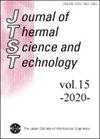多孔可燃物在液体氧化剂中的燃烧特性实验研究
IF 1.2
4区 工程技术
Q3 THERMODYNAMICS
引用次数: 1
摘要
燃烧特性的实验研究的测试样品组成的聚乙烯泡沫浸泡在100 wt%过氧化氢制成。所有实验均在先前工作中新引入的大体积室中进行,初始压力范围为p = 0.1至p = 0.35 MPa,燃料孔隙度范围为ε = 0.6至ε = 0.9,对应的整体等效比为φ = 0.51至φ = 3.8。然后使用嵌入试样中的r型热电偶进行温度测量,以研究燃烧试样的热结构(例如,温度和温度梯度的分布以及燃烧表面温度),从而深入了解燃烧过程。在试样顶表面强制点火后,在本工作所研究的所有条件下都成功地观察到稳定的连续燃烧过程。采用图像处理软件对试样的顶面进行仔细跟踪,测量燃烧速率(顶面向下移动的速率)。结果表明:总燃烧速率为1 ~ 3.2 mm/s,并受压力和燃料孔隙率的影响;另外,直接测温结果表明,随着压力的增加,靠近试样顶表面(燃烧面)的气相层温度梯度增大,导致整体燃烧速率增加。实验测量了试样的顶表面温度及其与压力的关系,以及顶表面温度下的整体活化能。本文章由计算机程序翻译,如有差异,请以英文原文为准。
Experimental investigation of burning characteristics of porous combustible soaked in liquid oxidizer
Experimental investigations of burning characteristics of a tested specimen consisting of a polyethylene foam soaked in 100 wt% hydrogen peroxide are made. All experiments are carried out in a large volume chamber, which newly introduced in our previous work at an initial pressure range from p = 0.1 to p = 0.35 MPa in absolute with various fuel porosity range from ε = 0.6 to ε = 0.9, which corresponds to global equivalence ratios from φ = 0.51 to φ = 3.8. Temperature measurements using an R-type thermocouple embedded into the specimen are then conducted to investigate thermal structure (e.g., profiles of temperature and temperature gradients and burning surface temperature) of the burning specimen for deep understandings of the burning process. Following forced ignition at top surface of the specimen, steady successive-burning process is successfully observed for all conditions studied in this work. Burning rates (a rate at which the top surface moves downward) are measured by carefully tracking the top surface of the specimen by adopting an image processing software. Findings show that overall burning rates at the rate from 1 to 3.2 mm/s are obtained and influenced by pressure and the fuel porosity. Additionally, results of the direct temperature measurements reveal that the temperature gradient in the gas-phase layer near the top surface (burning surface) of the specimen increases as pressure increases, resulting in an increase in the overall burning rate. The top surface temperature and its pressure dependency, and a global activation energy at the top surface temperature of the specimen are experimentally measured accordingly.
求助全文
通过发布文献求助,成功后即可免费获取论文全文。
去求助
来源期刊
CiteScore
2.30
自引率
8.30%
发文量
0
审稿时长
5 months
期刊介绍:
JTST covers a variety of fields in thermal engineering including heat and mass transfer, thermodynamics, combustion, bio-heat transfer, micro- and macro-scale transport phenomena and practical thermal problems in industrial applications.

 求助内容:
求助内容: 应助结果提醒方式:
应助结果提醒方式:


